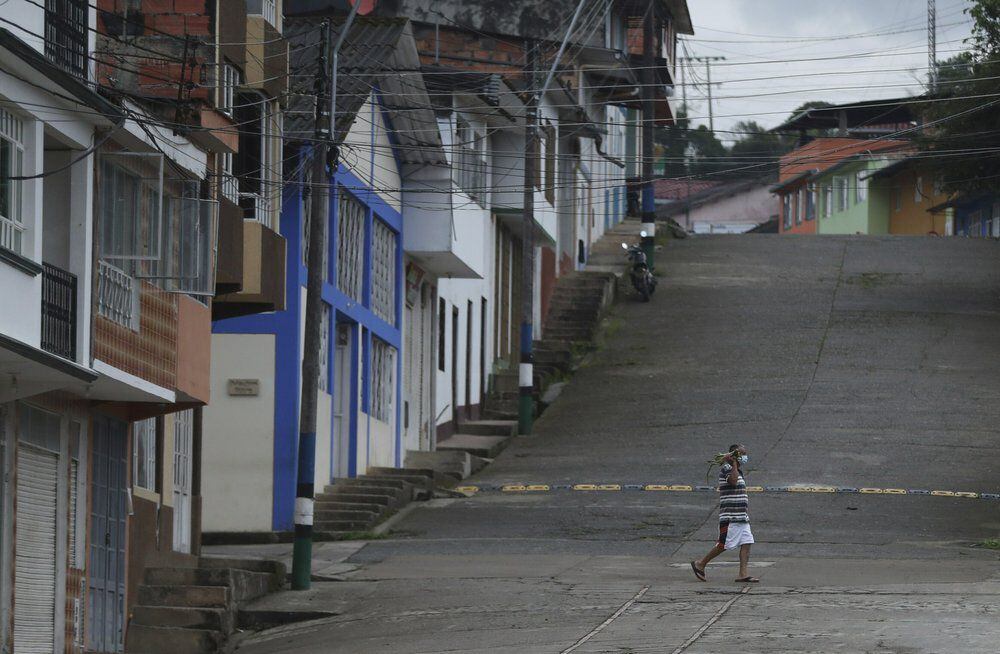When a customer enters his hardware store, Nélson Ávila asks him to wear a mask, clean his hands and then disinfect the bills and coins he receives with alcohol.
“I put them to dry in a box, because they are the ones that can be most contaminated, they pass from hand to hand and here we take great care of ourselves”the 49-year-old merchant told The Associated Press.
Nélson lives in Campohermoso, located in the department of Boyacá and one of the two municipalities of Colombia free from COVID-19. According to its inhabitants and authorities, this was achieved thanks to the discipline in the monitoring of biosecurity measures, prevention campaigns and its geographical location, 143 kilometers from Bogotá.
Campohermoso is a small town with only seven avenues and six streets in the urban area and no more than 3,400 inhabitants, mostly rural, who work in livestock and agriculture and the cultivation of cocoa and coffee.
- Two Venezuelan soldiers die and 32 Colombian “insurgents” are arrested after fighting on the border
- Iván Duque calls Nicolás Maduro a “murderer” for “persecuting, torturing, murdering and imprisoning” opponents
- The Colombian cemetery where the horror of the innocents killed by the Army is relived
At the beginning of the 20th century, they suffered from the armed conflict between paramilitary and guerrilla groups, recalled Mayor Jaime Rodríguez Romero. However, for more than a decade the violence has ended and its inhabitants live in a calm and simple way.
In Colombia, the presence of armed groups has put the population at risk and made self-care difficult in the pandemic. According to the Ombudsman’s Office in 2020, 28,500 people were displaced and confined throughout the country.
The town of Campohermoso is seen from above in Colombia, Wednesday, March 17, 2021. According to the Ministry of Health, Campohermoso is one of the two municipalities in Colombia that has not had a single case of COVID-19 since the pandemic began. (Globe Live Media Photo / Fernando Vergara).
After a year of pandemic, most of the inhabitants of Campohermoso wear masks and avoid crowds despite not having cases of COVID-19. Thus they have managed to reactivate their economy and open the doors of one of their schools to receive half of the students in person, rotating the groups, while the others study virtually. Nursing homes are the only ones still in lockdown.
“The population density is low. It is a municipality that is a bit far from the center of the department and does not have such close contact with capital cities where there are more infections, ”Jairo Mauricio Santoyo, Boyacá’s Secretary of Health, told Globe Live Media.
The mayor of Campohermoso believes that the key to keeping the town free of COVID-19 has been constant pedagogy through messages through megaphones, three times a day, and on the town’s community radio station. The mayor’s office gave away 1,000 radios in the rural area by identifying that there were families that did not have one and thus guaranteeing that the message would reach everyone.

Wearing a mask to slow the spread of the new coronavirus, a resident walks on a Campohermoso street. (Globe Live Media Photo / Fernando Vergara).
“We all came together in the town: the health center, the police, the Church and the mayor’s office to speak on the local station. It helped a lot to show them the statistics at the national and world level on the number of sick and dead. I told them: this is not my responsibility as mayor, nor the father’s, but yours. This transfer of responsibility made people think that they had to take care of themselves, ”Rodríguez told Globe Live Media.
From the local station they designed a program called Héroes en Casa, which deals with the pandemic and is aimed at boys and girls, said the radio broadcaster Cristian Sánchez Dueñas, 24, who every day remembers the biosecurity measures, especially on market days when people from rural areas visit the urban area to buy and sell basic necessities.
Entry to the town was not restricted and vehicles were not disinfected, as in other parts of the country. However, the outsiders had to be quarantined and received a daily call from a nurse to verify their health.

Wearing masks to slow the spread of the new coronavirus, students walk to the only open school in Campohermoso. (Globe Live Media Photo / Fernando Vergara).
“At one point, we had 60 families isolated. There were many suspects, they were tested and they came back negative, ”said the mayor, who was diagnosed with COVID-19 during a trip to Bogotá. However, he recovered before returning to avoid infecting others.
The town’s Catholic priest, for his part, assured that the community has been spiritually committed through constant prayers. “Above all we have prayed to San Roque. He is the patron of this parish and the protector of the sick and epidemics. I also associate him with pandemics … he really is the saint of COVID in Boyacá ”, said the parish priest Camilo Antonio Monroy.
In Colombia, the pandemic has so far claimed the lives of more than 62,000 people and 2.3 million cases have been confirmed, according to the Johns Hopkins University Center for Science and Systems Engineering.

Wearing masks to slow the spread of the new coronavirus, students attend classes at the only open school in Campohermoso. (Globe Live Media Photo / Fernando Vergara).
According to the Ministry of Health, in January there were 18 municipalities free of COVID-19. However currently there are only two, Campohermoso and San Juanito, located in the department of Meta, in the east of the country.
Colombia surpassed one million vaccines supplied to its inhabitants on Wednesday and 60 million doses remain to be applied to meet the goal set by the government of immunizing 70% of its population with Pfizer, Sinovac vaccines -which have already arrived in the country- and those of Moderna, AstraZeneca and Janssen.

:quality(75)/cloudfront-us-east-1.images.arcpublishing.com/elcomercio/DMTD7HGINFBBFMWT7JCNRYUFDU.jpeg)